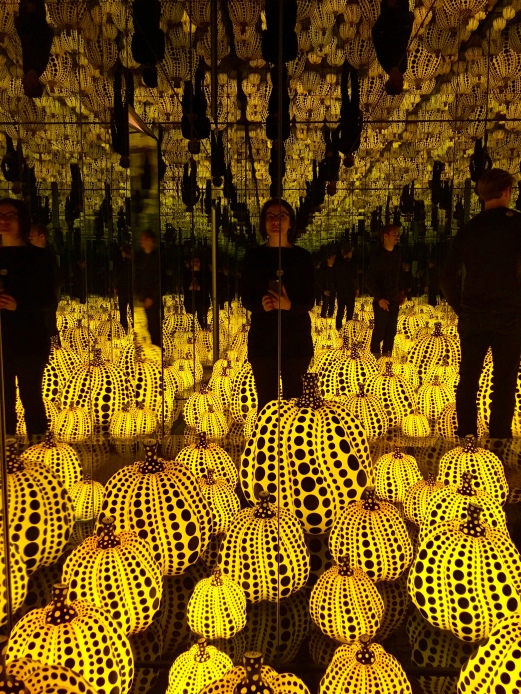Math has never been my forte. But I did some anyway after a weekend in DC. Start to finish, I spent five hours waiting to see Yayoi Kusama’s Infinity Mirrors at the Hirshhorn.
I last queued for that long a couple of years ago, when my husband and I took our kids to Disney World – my first time experiencing its glory, decadence and madness.
The time before that was in Moscow, in 1990, when McDonalds opened its first store and my great-grandmother and I joined thousands for our first taste of Big Mac (and for a signature brown tray that my great-grandmother stole in her coat because, “These capitalists can afford it!”)
For Kusama, I woke up at 6:30am on a Sunday, Lyfted to the museum, and stood outside in 28-degree weather, Soviet-style, until about 10, when the attendants opened a giant white container through which we further snaked our way for about an hour until – lo! – we were allowed inside and given our tickets.
Later that afternoon, when my family and I returned for the 3pm show, we waited for another 20-30 minutes for each of the Infinity Rooms, managing to see five of them. For 20 seconds each.
100 seconds in Kusama’s ethereal universes – for five hours of waiting. Even if you add the peep-show style exhibits with shorter queues, the works on the wall, and the floor installations, the experience of Kusama’s art doesn’t last much longer than an hour. You reach your limit physically and emotionally.
Was it worth it? Every single patience-testing moment.
The exhibition and the way it has been promoted, presented and attended puts it squarely in the category of a cultural phenomenon. Not unlike the first McDonalds in the Soviet Union or Disney World, which – culturally, aesthetically, and, yes, even intellectually – opened my eyes to new worlds so different from the ones I inhabited at the time. And a cultural phenomenon is best witnessed first-hand, even if that doesn’t come easy.

The 20 seconds you get in each Infinity Room – a limit strictly observed by attendants with stopwatches – isn’t nearly enough. You could spend 20 minutes, an hour, a half day in each space, likely reaching meditative levels we only dream of in our fleeting Shavasanas in yoga class.

As a child, I watched my mother and her friends tell the future in a darkened room in our Moscow apartment. They would hold a small mirror in front of a large one, and stare into the tunnel, seeking in the abyss an image of The One. Kusama’s mirrored rooms, dangling with lights or lined with her signature pumpkins – create an ambience of similar mysticism. As your gaze reaches into endlessness, you lose sense of yourself, of what is real and what could be a vision.
Could the 20 second limit be in place not only for crowd control but also because after a short while, we would begin to lose ourselves in the experience?
The Hirshhorn can’t afford to have us reaching transcendence within its walls. But Kusama’s work launches an internal process that we all need and can carry within us long after seeing the exhibition.

Despite the fact that nearly everyone takes selfies in the rooms, there is something distinctly selfless about being in these spaces. While forming an intimate, unique experiential bond with those who enter with us – that connection with others that we crave and yet, of late, have a harder time achieving – the rooms also remove us from ourselves. To consider our place in the universe. To conceive how many just like us there have been and will be. To observe the reverberations when we intentionally push or accidentally bump into a single dangling light.
The experience of waiting so long for something so fleeting is not entirely aligned with the definition of millennials – and yet millennials wait in troves. We might be taking selfies and speed-tagging #InfiniteKusama, yet there is no getting us away from the pervasive sense that much-needed feeling that we are participating in something bigger than ourselves.
When you leave the Hirshhorn, reality setting in, you come face to face with the Department of Education to your left, the Department of Energy to your right. In that moment, it doesn’t feel like coincidence. Do the buildings before us represent the future we want to see?

Over the coming days, you can’t help drifting back to those rooms, those endless dots. Dots that Kusama, as much as she loves them and as carefully as she presents them, is sure to never connect for us. We get to do that ourselves.
Two weeks post-show, the lure of endless lines is making more sense. Even when we don’t know what they’re for, it seems we do know to trust the universe when it reveals its once-in-a-lifetime offers.
Yayoi Kusama’s Infinity Mirrors is on view at the Hirshhorn Museum in Washington, DC through May 14, 2017.







I agree with all of your wonderful observations – Kusama’s exhibit is truly transcendent! In retrospect, however, I considered the time limit for each Infinity Mirror room in a different way. My take was, especially for the pieces that had clear, looped effects, that Kusama may have been ambivalent toward or even intended ephemeral viewer experiences. Too much time spent in one room might lead to overly intense investigation of materials or construction, or even one’s own image. To me it seemed that a brief jolt of awe was, in fact, more poignant and possibly more enjoyable than lingering and perhaps losing suspension of reality in the craft of the art itself.